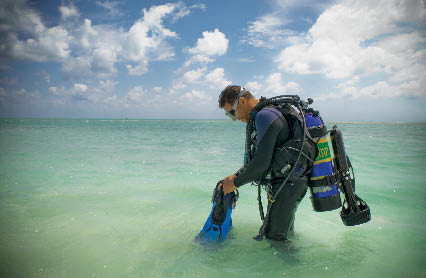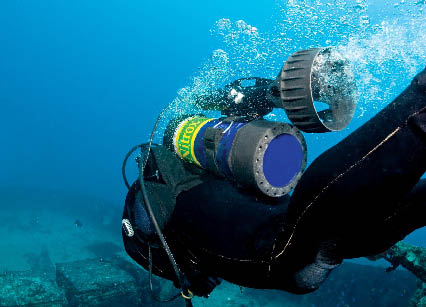Look, Ma, No Hands UnderwaterContents of this Issue: Saipan, Statia, Lake Malawi, Key Largo... Gulf Coast Dive Shop Files Lawsuit Against BP At What Cost For a Third Dive? A Dive Camera that Floated 1,000 Miles and Still Works A New Twist on Divers and Drugs Editorial Office: Ben Davison Publisher and Editor Undercurrent 3020 Bridgeway, Suite 102 Sausalito, CA 94965 a DPV thatís easy to maneuver and not too pricey from the July, 2010 issue of Undercurrent
The remote control was gripped firmly between the handle of my big camera housing and my hand. I held my other camera housing handle and looked through the viewfinder. Things didn’t look promising. I’d been hoping to try the Pegasus Thruster by sweeping majestically round the wreck of the Spiegel Grove in the Florida Keys. High winds had made diving there impossible so I was reduced to immersing myself in a Florida creek with lousy visibility. However, I had come a long way and, with a retreat back to the U.K. impossible thanks to a plume of volcanic ash over Europe, I was going to make the best of a bad job. I pressed the big “go” button and, after the electronics checked out that everything was technically okay, I was off, silently, travelling effortlessly, chasing Dean Vitale, equally equipped, through the murk to get some pictures. What was unique about our transport was that I was totally hands-free and able to use my camera, unlike other Diver Propulsion Vehicles (DPVs) that require you to either hold on with two hands or be towed by a lanyard, steering by rotating the DPV with one hand. But with the Pegasus Thruster, I was hands-free and merely had to turn my torso a little to control my direction of travel. If I wanted to stop, I simply released the magnetic switch in the remote control, and the effect was immediate. I looked where I was going, pressed the button and that is where I went. It was so easy and simple. And, for a serious diver, not prohibitively expensive at $2,350 for the basic unit. They’re Getting Popular
I had previously met Vitale at Pinewood Studios in the U.K., where he was testing a Thruster with an underwater cameraman. Since then, they have come up with ways for using the Thruster with a remotely operated camera. Vitale had originally conceived the Thruster for use by disabled divers, and continues to work with the Wounded Warriors organization. It’s ideal for them, but others also recognize that you can do a lot more work underwater if your air consumption is not being taken up by your effort to produce kicking power. Security services have found that with the Pegasus Thruster, they need less manpower to conduct under-hull inspection of ships entering Miami Harbor. The U.S. military is experimenting with it, and Vitale will soon demonstrate it to the Seabees (U.S. Navy construction divers). Woods Hole Oceanographic Institution has purchased units, as have Florida’s Department of Transportation bridge inspection teams. Even British security services in charge of the 2012 Olympics in London have noted that they can inspect more underwater structures, such as the bridges over the Thames, if their divers are equipped with these devices. The future looks bright for the Pegasus Thruster. I first saw a prototype Thruster a couple of years ago at a DEMA show but it was not until Vitale got the commercial backing of Miami businessman Patrick Gleber that he was able to get it into production. The concept was to produce a sleek device that could be mounted on a scuba tank and BC, and be easily controlled - - even by someone who had no use of his hands, for example, by squeezing the control under the chin. The remote control at the end of its lead uses a magnetic switch that will avoid wear by employing repelling properties caused by the reversed polarity of two magnets. The motor was developed from a well-known, high-torque, electric motor normally used for heavy-duty power drills. However, unlike a drill that might be used to attack concrete, all the Thruster’s motor has to do is cope with the viscosity of water. It promises a long life.
The unit includes sensors that disconnect the motor when the voltage gets low, and there is an automatic clutch release. All the circuit boards are laminated in silicone. Overall, it gives more than 15 grams of thrust, which I appreciated during the times that I held on to Vitale’s ankle and he dragged me around while I made close-up pictures of the big whirling propeller and its shroud of the Thruster that he was using. The unit is mounted via a bracket and camband attached low down on the tank to give clearance for the propeller. This is a quick-connect device and when you are ready to dive, the whole Thruster is simply snapped into place. After a dive, you remove it in a moment by pulling a pin and unhitching it, and you can sit down. It’s very convenient. The cable of the remote control is connected via a wet connector and, very unusually, the battery pack can also be connected or disconnected from the drive while still underwater. This gives the option of extending the 45-minute duration by changing batteries during the dive. (A second battery is $600.) The battery pack and power-train snap together to form a slim, torpedo-like shape, more slim than even the most lightweight DPV. Vitale manufactures and hand-assembles the Thruster in a small facility in Florida. It’s beautifully crafted in anodized aluminium with a high-impact plastic shroud and propeller. Like so many good ideas, the basic concept is so obvious, one wonders why no one else has thought of it. By mounting the unit on the tank, it becomes not at all intrusive, and if you want to fin without its assistance, you certainly don’t notice it being there. I found it was perfect for stopping, resorting to conventional finning while taking a picture, then moving on again. Circling The Spiegel Grove on One Tank After a week of waiting, the weather cleared. Vitale took me out in Gleber’s fast (40 knots) fishing boat to dive both the Spiegel Grove and the Duane. The Spiegel Grove is a vast wreck (it was a military hovercraft transport ship) but it took no time to zip round the whole thing, pausing at times to take pictures. I didn’t go deeper than 105 feet but stayed a long time at that depth and found that the Nitrox in my 80 cu. ft tank easily lasted the dive. We startled a couple of giant groupers that weren’t expecting us to approach so quickly and hurtled through thick shoals of Atlantic spadefish and pompano jacks. As we made our way back to our up-line, a huge school of silvery barracuda came flooding into the wreck. It was nice to know that the up-line was never far away in terms of time. A little pressure on the remote control sent me zooming back the way I’d come. The Duane is a deep wreck and I limited myself to120 feet. It is full of fish including a couple of big grouper and lots of toothy barracuda that I could get really close to. Fish here are not used to divers zipping so quickly over to them, and it’s easy to hold your breath while you are doing it. This wreck is often swept by strong currents, which could lead to some anxiety about getting back to the mooring line - - but not with a Thruster mounted on my tank. As soon as I wanted to go back, I went, and when I say “I went,” I really went. Because it was unnecessary to avoid the current by being close to the deck of the wreck, I could travel through blue water and complete a slow ascent as I went. The 45-minute run-time proved adequate for the dive, considering that I didn’t run the Thruster while I took pictures. (45 minutes is the typical battery life before recharging, which takes 2.5 hours.) Of course, actual speeds and run times vary depending on the amount of drag. With a wetsuit and single tank, I found it certainly sped me along but not so quickly that I would be worried about the water-tightness of my camera housing. Maximum speed is about two knots, or 165 feet per minute. You can fit one Thruster to twin tanks or you can fit twin Thrusters, in which case it is possible to use ones with counter-rotating propellers so there is no pronounced torque-effect that would make it easier to turn one way than the other. With the single unit, I noticed no such effect and found I could go easily in any direction including downwards. Because it is hands-free, I could easily pinch my nose to clear my ears as I descended, too. (You must take care not to ascend too quickly with any DPV.) The whole thing measures less than two feet long and the widest part, the shroud, is about 8.5 inches in diameter. It weighs 12 pounds and is 5.5 pounds negatively buoyant in seawater. The Thruster Diver Bundle includes a Pelican case with two battery packs, the tank-bracket assembly, tank strap, battery-charger and the remote control with its magnetic switch. It retails for $3,275. Finally, I must say that using a DPV on small dive boats is often an imposition to other divers, as Undercurrent has noted in the past. But not the Thruster. It even fits into a typical tank rack. Tell me of another DPV that does that! For more information, go to www.pegasusthruster.com P.S. After Ben reviewed my article, he suggested I was too positive about the Thruster. “Aren’t there more shortcomings?” he asked. My answer: “Ben, you know that I am very critical when I need to be but I can assure you that, price aside, I don’t have a bit of fault with this. I want one!” John Bantin is the technical editor of DIVER magazine in the United Kingdom. For 20 years, he has used and received virtually every piece of equipment available in the U.K. and the U.S., and makes around 300 dives per year for that purpose. He is also a professional underwater photographer. |

I want to get all the stories! Tell me how I can become an Undercurrent Online Member and get online access to all the articles of Undercurrent as well as thousands of first hand reports on dive operations world-wide
| Home | Online Members Area | My Account |
Login
|
Join
|
| Travel Index |
Dive Resort & Liveaboard Reviews
|
Featured Reports
|
Recent
Issues
|
Back Issues
|
|
Dive Gear
Index
|
Health/Safety Index
|
Environment & Misc.
Index
|
Seasonal Planner
|
Blogs
|
Free Articles
|
Book Picks
|
News
|
|
Special Offers
|
RSS
|
FAQ
|
About Us
|
Contact Us
|
Links
|
3020 Bridgeway, Ste 102, Sausalito, Ca 94965
All rights reserved.


 The power to the propeller goes via a gearbox with a clutch mechanism that prevents damage if the propeller gets fouled. The 12-volt NiMH battery gives enough “current draw” for its application without being unstable, particularly important when seawater is in the vicinity. Vitale says, “It gives enough grunt!”
The power to the propeller goes via a gearbox with a clutch mechanism that prevents damage if the propeller gets fouled. The 12-volt NiMH battery gives enough “current draw” for its application without being unstable, particularly important when seawater is in the vicinity. Vitale says, “It gives enough grunt!”